When diagnosing gout, both doctors and medications recommend that patients start by changing their diet. A gout diet is an important part of the complex treatment of the disease. Its use will speed recovery as much as possible, relieve pain symptoms quickly, reduce the severity of attacks, and prolong remission.
Principles and Benefits of Diet
The main goal of dietary therapy is to organize such a diet to help combat pathology and prevent relapse. For gout, the purpose of the diet is to:
- Regulate purine metabolism;
- Decreased urate levels;
- normalization of the process of removing excess uric acid;
- regulation of metabolic processes;
- increase the alkalinity of urine;
- weight loss when overweight;
- The general health of the patient.
On the basis of the principles of treatment and the rules of the diet plan, a hypopurine type of nutrition is being developed, including the prohibition of foods high in purine compounds, salts and oxalic acid. There is also a need to reduce the amount of fat, carbohydrate and protein compounds consumed.
Gout treatment nutrition and diet increase the proportion of vegetables, fruits, natural beverages, kefir, cottage cheese in the diet. The most effective is a proper nutritional regimen of 4-5 servings at a time with an average calorie content in the range of 2500-2800 units.
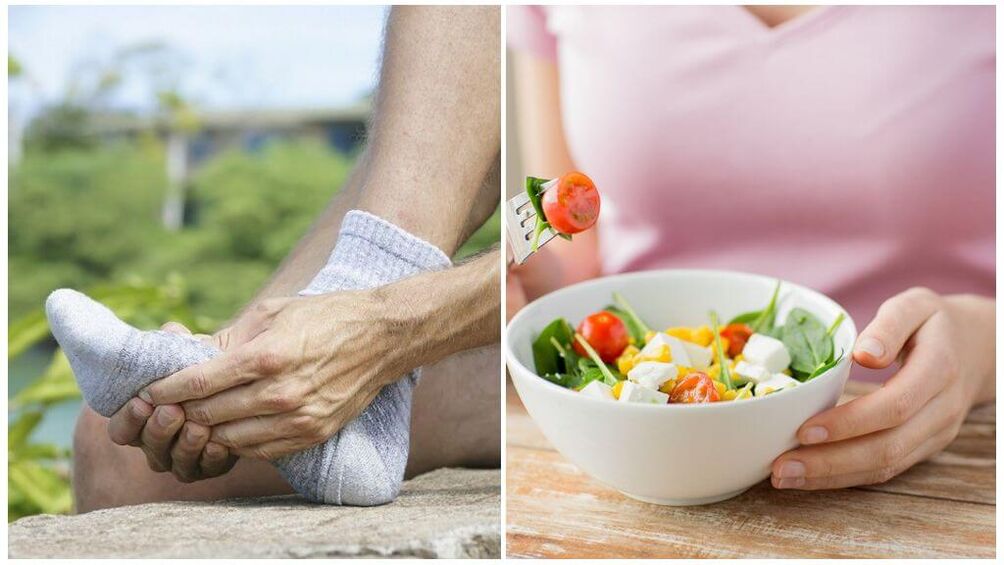
important!
Drink in such a way that the amount of fluid flowing into the body is 2. 5 liters or more.
How to plan meals
To maximize the effectiveness of the gout diet, you must follow several recommendations:
- The main cooking methods are boiling, roasting and steaming;
- Drain the broth after 10 minutes of cooking;
- Substitute meat, fish and vegetarian dishes;
- Use only natural liquids;
- spend fasting days;
- Avoid fasting.
important!
In the presence of chronic diseases, it is necessary to contact a specialist to develop an individual nutritional system.
Main diet type
Appropriate therapeutic nutrition of the tissue will not completely eliminate gout, but will significantly alleviate the pathological manifestations and prevent its recurrence. The type of diet prescribed depends largely on the patient's general condition, weight, presence of other medical conditions, and even gender.
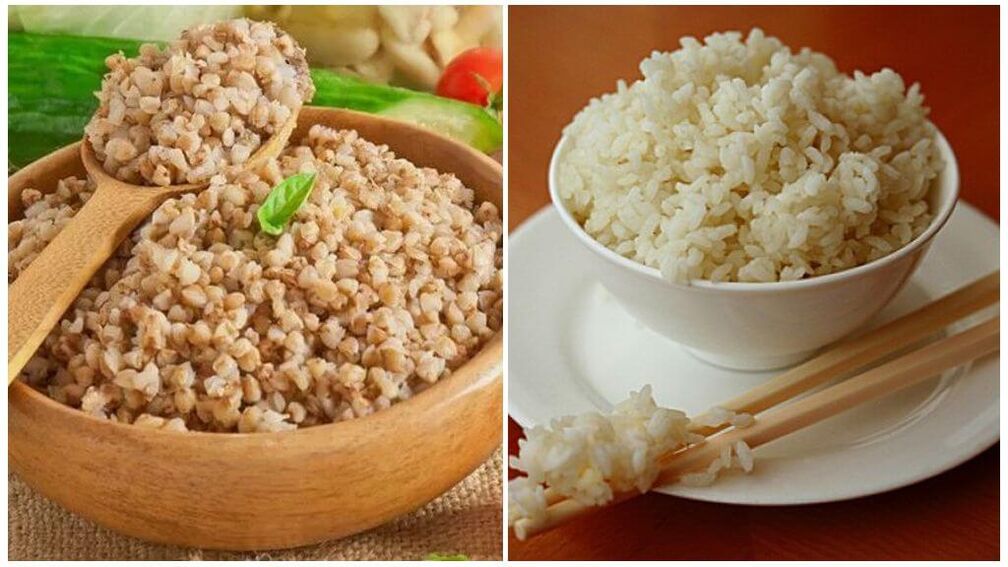
The main medical nutritional type for gout is diet - Table 6. In addition to this, gout patients, especially those with shortness of breath and overweight, often use the Diet Table 8, alkaline, rice, and buckwheat diets. A kefir, cottage cheese, fruit or vegetable diet is perfect for fast days.
Diet Chart No. 6
It was first used for gout sufferers. It normalizes the exchange of purine compounds in a short time and eliminates the cause of urate crystallisation and accumulation.
Compliance with nutritional requirements reduces the activity of the uric acid response in the body. As a result, the patient's health improves rapidly, the inflammatory process stops growing, swelling decreases, and joint pain and stiffness disappear.
high uric acid diet
It is based on rejecting or reducing the menu of products with high purine, refractory fat, salt index.
It is recommended to replace them with products with an alkalizing effect: dairy products, yogurt, cottage cheese, fruits and vegetables. The diet dictates fasting one day a week.
Gout exacerbated diet
First, during exacerbations, you will need to increase the amount of fluids you drink to 3 liters. Then completely exclude dishes with meat and fish. The lack of animal protein can be compensated by increasing the proportion of dairy and yogurt products in the diet.
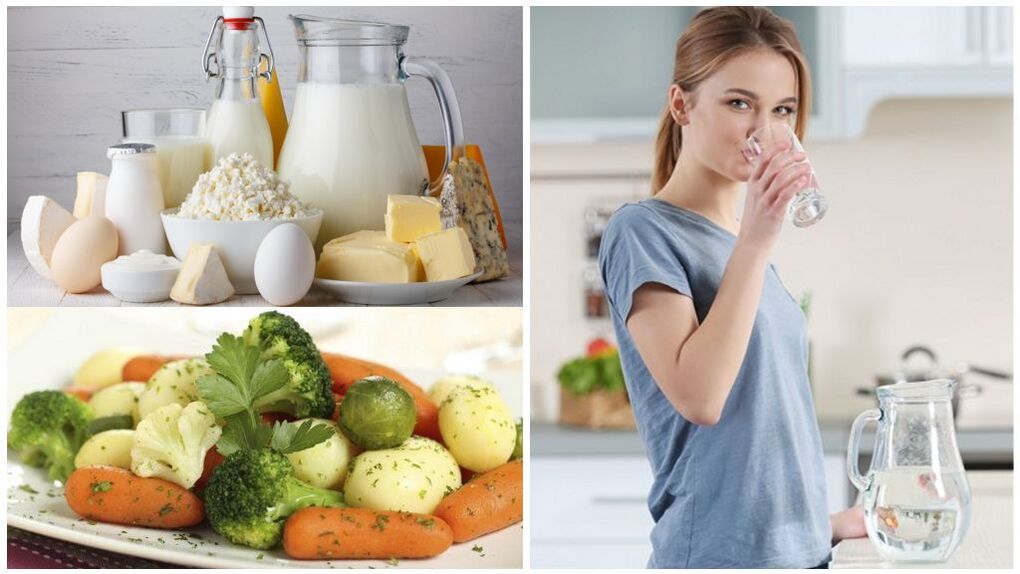
Fasting days must be scheduled every other day with one food (cheese, kefir, boiled vegetables, fruit) until the acute phase of the illness ends.
important!
Fasting can cause a sharp release of uric acid, and people with gout are strictly forbidden to eat.
Diet Chart No. 8
Table 8 provides strict guidelines for the nutrition of gouty legs in severely overweight patients. This diet is designed to increase metabolism and eliminate excess body fat.
In this case, the main difference from the general requirements of a gout treatment diet is a modest reduction in caloric content and water intake, averaging a maximum of 1. 5 liters per day.
Notice!
For men with gout, dietary regulations keep the calorie content of foods at a level of no less than 2100-2500 units. For gout in women, the No. 8 diet limits the menu to between 1400 and 1700 calories.
Buckwheat Diet
Buckwheat's low calorie content makes it useful for therapeutic dietary nutrition. Its consumption restores disturbed metabolic processes, quickly creating a feeling of satiety, allowing you to forget about hunger for a long time. Buckwheat is the leader in vitamin and various trace element content.
Plant-based cereal proteins are better absorbed and can completely replace animals. During the recovery phase of bone and muscle tissue, the product aids in the regeneration process. Buckwheat porridge combined with kefir is ideal for gout fasting days.
Notice!
Buckwheat is usually prepared with diet foods without salt. The buckwheat diet allows you to lose weight quickly, which has a positive effect on the joints susceptible to the devastating effects of gout.
rice diet
Rice-based diets are most commonly used for body cleansing and weight loss. Gout rice can speed up metabolism, remove excess water and salt, and reduce swelling very well. Manganese, selenium, phosphorus, iron, zinc are part of rice and have beneficial effects on all life support systems of the body.
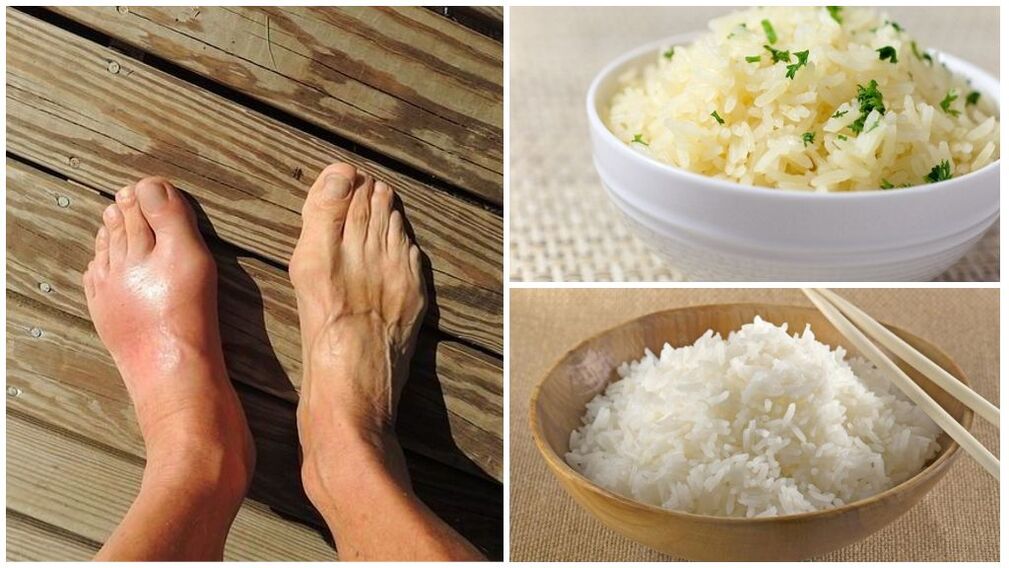
The porous structure of the grain draws out accumulated harmful toxins, salt and slag from the lesions. The rice diet can also be used on fast days, especially during gout exacerbations.
important!
For the diet, use only brown or white long grain steamed rice. These grains can be used daily when treating gout with nutrition.
alkaline diet
Increased acidity in the body can negatively affect metabolic processes. This is accompanied by a lack of calcium and the destruction of bone tissue. Using an alkaline diet will help prevent processes that harm your health. The basis of the diet is fruit, yogurt and dairy products. This diet can be used both during gout attacks and during remission.
Prohibited and Permitted Products
To properly rebuild your nutritional system, you need to know which foods are good and helpful for gout and which foods can have harmful effects and make the disease worse.
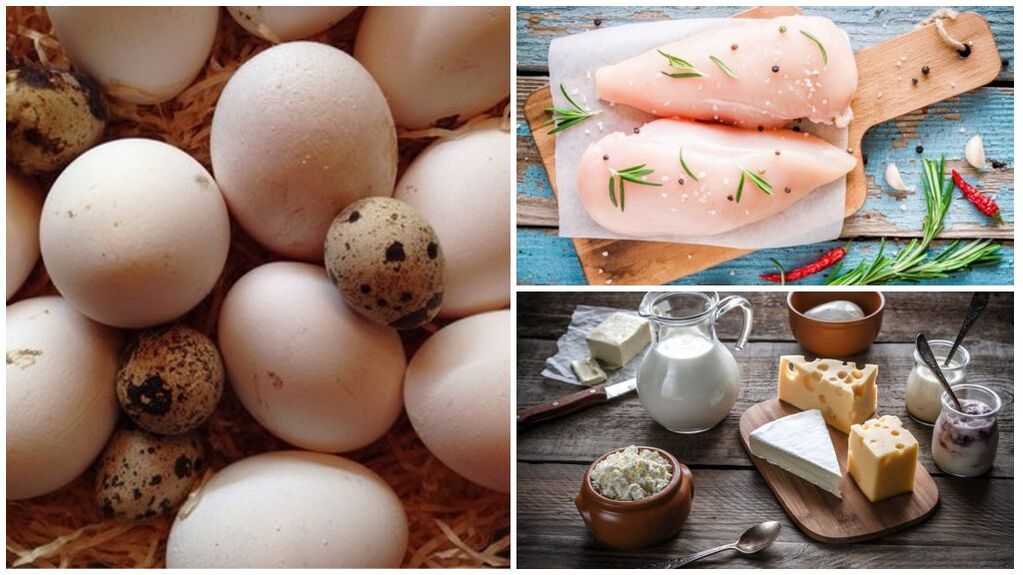
According to the quantitative content of purines, salts, fats and other harmful substances, all foods can be listed in the gout staple food table. The main marker that divides the list of gout products is the content of purine compounds.
| high purine content | low purine |
|---|---|
|
|
important!
People with gout are strictly prohibited from drinking any alcoholic beverages.
what products are useful
By determining the amount of purines and unhealthy fats in foods, you can know exactly which foods to eat with gout without harming your health, and which foods to limit.
Notice!
Fruits in the product group that are particularly useful for gout include pears, bananas and apples. Malic acid is part of the fruit that neutralizes the effects of uric acid.
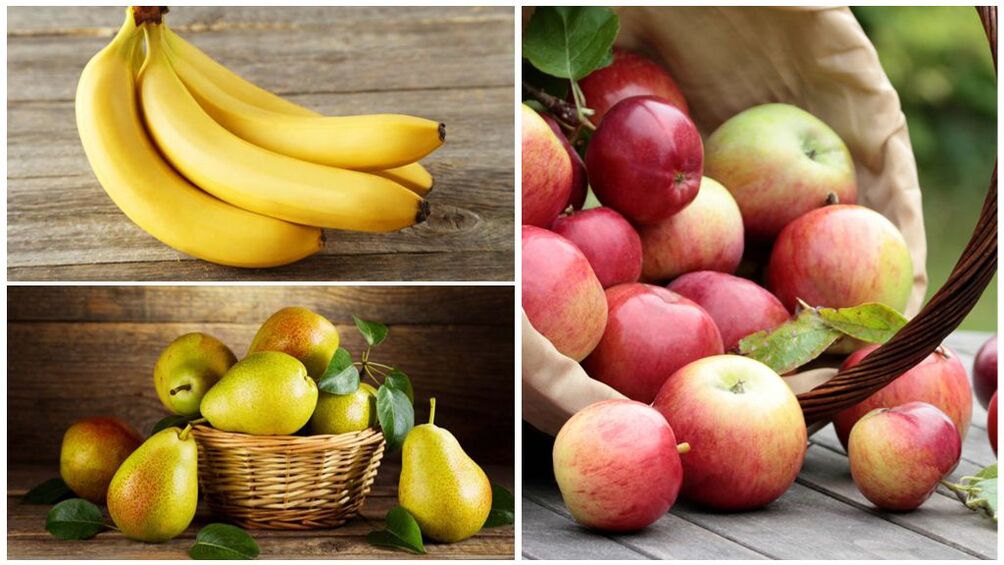
Potassium destroys uric acid crystals, which helps speed its removal from the body. Ascorbic acid heals, restores and strengthens connective joint tissue. Of particular use is fruit nutrition in fermented dairy compositions.
The great benefits of gout will bring the regular use of fresh cherries and candied cherries. Berries contain antioxidants that fight free radicals. Bioflavonoids and anthocyanins prevent the inflammatory process of gout.
The useful substances contained in strawberries and strawberries neutralize uric acid and prevent its crystals from forming in the joints.
Notice!
You can add unlimited amounts of these berries and fruits to your gout diet.
what foods not to eat
In addition to the products listed in the summary table, thick meat, fish and mushroom soups must be excluded from the diet. They are contraindicated because of their high purine content, which can cause gout to worsen dramatically. Not advisable are canned fish and meat, which contain a large proportion of salt. Their use with a purine diet can disrupt the water-salt balance and cause additional deposits of salt in joint tissue.
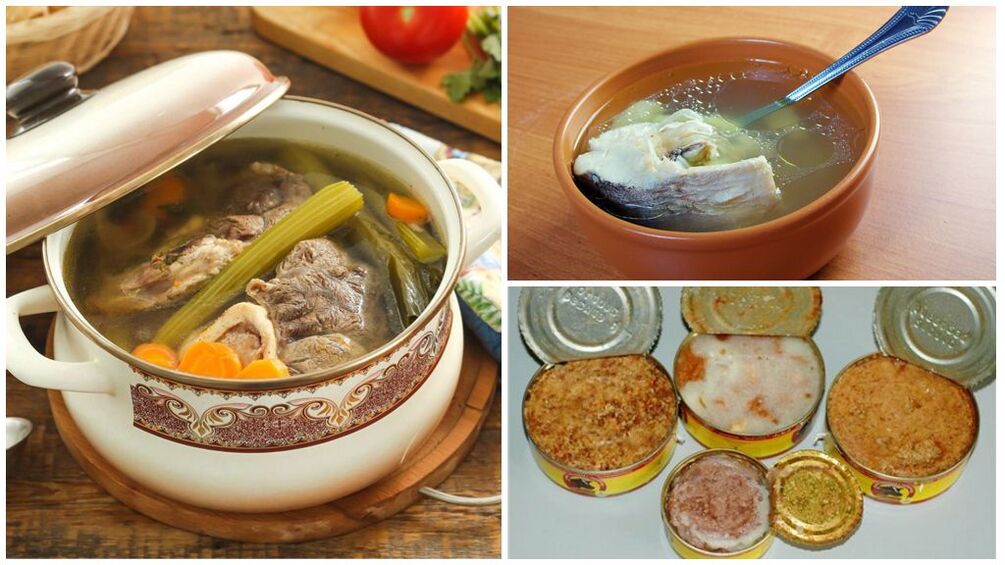
The gout fasting list also includes tea, coffee and cocoa. These beverages should not be consumed with gout because they retain uric acid in the body, disrupting its withdrawal process. This leads to a recurrence of the disease.
daily menu of the week
There is a wide variety of products allowed for consumption, and dishes can be individually selected and eaten correctly for any gout sufferer. The recommended diet for this week is balanced, complete, and consists of foods that are useful for gout.
| breakfast 1 | Omelet with Herbs, Rosehip Broth, Carrot Salad |
| breakfast 2 | banana, kefir |
| dinner | Vegetable soup powder, boiled potatoes, rabbit meat in onion sauce, apple juice |
| afternoon tea | Apple, Cheesecake, Lemon Tea |
| dinner | zucchini caviar, kissel |
| breakfast 1 | Rice porridge, pear soup, tomato salad |
| breakfast 2 | fruit salad, kissel |
| dinner | Onion soup, forest mushroom barley porridge, dried fruit preserves |
| afternoon tea | Pear, Pumpkin Fritters |
| dinner | Curd souffle, linden tea |
| breakfast 1 | Wheat porridge, apricot juice |
| breakfast 2 | Cherry Yogurt, Rosehip Soup |
| dinner | Fish ball soup, stew, apple jelly |
| afternoon tea | Cheesecake with Sour Cream, Preserves |
| dinner | Plum pilaf, kefir |
| breakfast 1 | Rice Casserole, Smoothie, Apple Coleslaw |
| breakfast 2 | Strawberry Cream, Green Tea |
| dinner | Beetroot with sour cream, buckwheat, turkey breast with plum, mint tea |
| afternoon tea | Strawberry Pancakes, Carrot Juice |
| dinner | Cheese Casserole with Herbs and Pear Preserves |
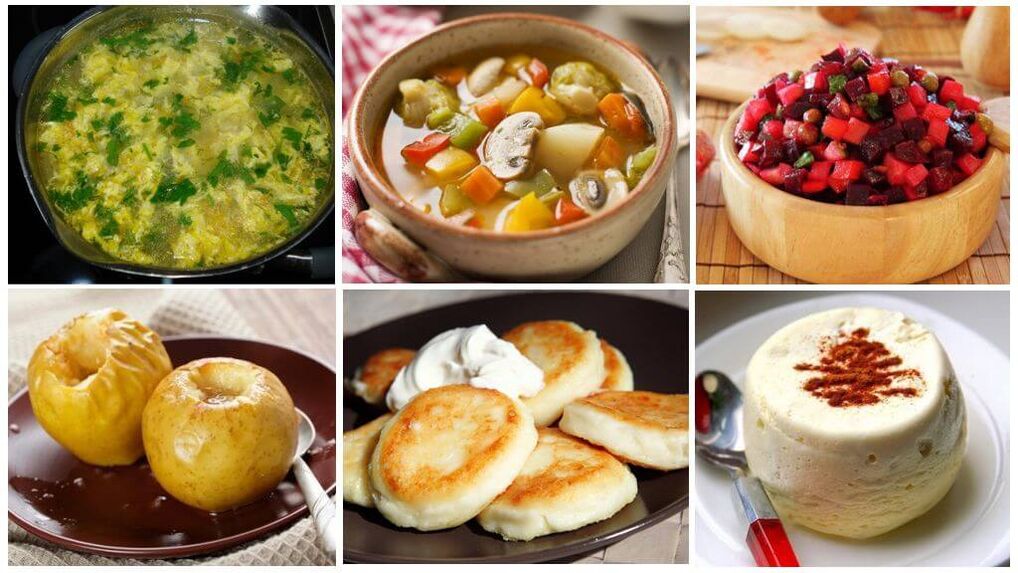
| breakfast 1 | Oatmeal with raisins, tomato juice, fruit salad |
| breakfast 2 | Cucumber Salad with Olive Oil, Orange Juice |
| dinner | Buckwheat Soup, Zucchini Rice, Orange Juice |
| afternoon tea | Banana, Oatmeal Jelly |
| dinner | Steamed Fish with Vegetables, Kefir |
| breakfast 1 | Millet milk porridge, plum juice |
| breakfast 2 | Salad with baby carrots and garlic, plus an apple |
| dinner | Egg soup, cabbage wraps with vegetables and turkey, apple juice |
| afternoon tea | Cheese with Banana, Strawberry Tea |
| dinner | Rice pudding, tomato juice |
| first breakfast | Poached eggs, green tea |
| second breakfast | Pear, Green Tea Marshmallow |
| dinner | Meatless borsch, macaroni and cheese, fruit preserves |
| afternoon tea | Baked apples with cottage cheese, lemon drink |
| dinner | Balsamic Vinegar, Linden Soup |
As a supplement to the main menu, allowed vegetables and fruits are available in unlimited quantities. Gout sufferers are best off wheat bread, including the big toe.
important!
Foods with natural honey added to treat gout can cause allergic reactions.
diet recipes
This week's suggested sample menu includes many diet dishes, tailored to your dietary needs. If needed, replace them with others using the list on the Gout Permitted Foods table and advice on what people with gout can and cannot eat.
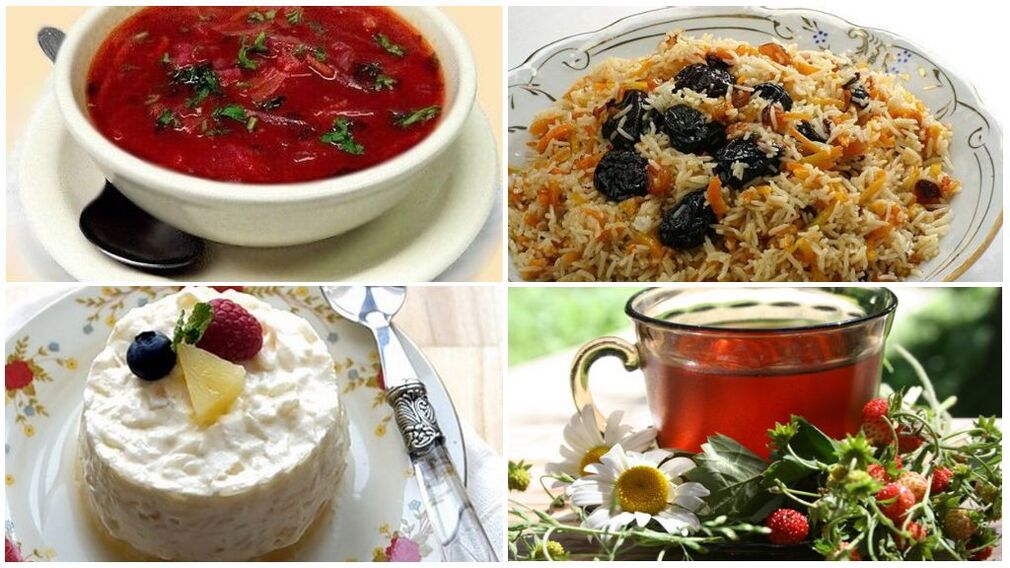
borsch soup without meat
1 beet, carrot, onion peeled. Simmer diced onion and root vegetables grated on a coarse grater in olive oil and add tomatoes or 1 tablespoon. l. Tomato. 4 potatoes cubed and boiled in 1. 5 liters of water. 10 minutes. Once cooked, add the shredded fresh cabbage. 5 minutes. - Stews. Season with salt. To serve, add parsley, dill, and a spoonful of sour cream.
Plum pilaf
Rinse a cup of rice. In a large pot with vegetable oil, add 2 striped onions and 2 cubed carrots. Bring everything to a simmer. Add 10 slices of washed and chopped plums. We go through everything until the vegetables are tender. Pour in the rice, stir until the oil is completely saturated, and pour in 2 cups of boiling water. Add spices and salt to a minimum. After boiling, reduce heat, cover tightly and cook for 20 minutes.
rice pudding
Cook half a cup of rice in 1 liter. water for 10 minutes. Drain the water and rinse the rice. Pour in a glass of milk and cook for another 25 minutes. until you get soft porridge. Beat 2 eggs and steam 50 grams of raisins. Mix everything with cooled porridge, add salt and 1 tsp to the tip of a knife. Sahara. Bake in the oven over medium heat in a greased pan until golden brown. Serve with cherry syrup.
strawberry tea
Pinch a pinch of dried strawberries into a glass of boiling water and soak for 3 minutes. Drink without sugar.
Using these recipes every day, you can improve your health and reduce pathological manifestations.
in conclusion
Proper nutrition for gout should become a daily norm in the patient's life. This will slow down or even stop the development of the pathology altogether. As a result, it will be possible to protect other organs from damage.
important!
It must be remembered that diet is a supplement, not a substitute for medication. The advice of a rheumatologist must be followed at all stages of treatment.

















































































